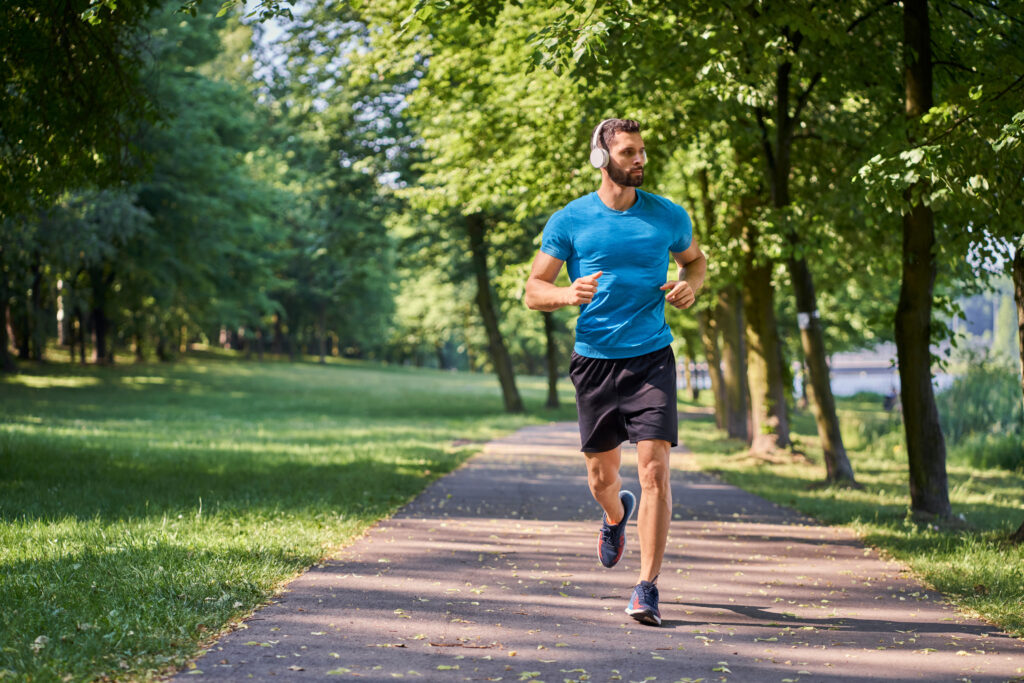Running or jogging is an excellent form of physical activity that can provide numerous health benefits. In addition, it is an inexpensive and convenient form of exercise that can be done almost anywhere and at any time. However, before running to the next branded shoe store with your wallet, it is essential to understand the benefits and precautions associated with this form of exercise while initiating the program.

Benefits of Running or Jogging for your Health
Improved Cardiovascular Health
Running or jogging can improve cardiovascular health by strengthening the heart and lungs. A systematic review and meta-analysis found that, in addition to the above, it can also significantly reduce blood pressure in people with hypertension (Cornelissen & Smart, 2013).
Weight Loss
Running or jogging can be an effective way to lose weight. Regular running or jogging can help burn calories and increase metabolism, resulting in weight loss over time (Jakicic & Otto, 2005).
Improved Bone Health
Running or jogging can help to improve bone health and reduce the risk of osteoporosis. The American College of Sports Medicine recommends weight-bearing activities like running or jogging to promote bone health (Kohrt et al., 2004).
Improved Mental Health
Running or jogging can also have a positive impact on mental health. For example, exercise, including running and jogging, has been shown to reduce symptoms of depression and anxiety (Craft & Perna, 2004).
Precautions for Running or Jogging
Risk of Injury
Running or jogging can lead to injuries, particularly in the lower extremities. A systematic review found that the incidence of lower extremity injuries in long-distance runners was as high as 79%, with the knee being the most commonly injured site (van Gent et al., 2007). Wearing appropriate footwear and using the correct running technique can help reduce the risk of injury.
Choosing the Right Footwear
Wearing the wrong footwear can increase the risk of running injuries. A study found that assigning shoes based on foot shape reduced the incidence of injuries in Air Force basic training (Knapik et al., 2010). Choosing appropriate footwear that fits well and provides adequate support is crucial.
Stretching
The impact of stretching on sports injury risk is controversial. A systematic review found that stretching before exercise did not reduce the risk of injury, but stretching after exercise may help to reduce muscle soreness (Thacker et al., 2004). Therefore, stretching correctly and avoiding overstretching is essential, which can increase the risk of injury.
Proper Hydration
Proper hydration is essential for running or jogging. Drinking water before, during, and after exercise is recommended to prevent dehydration and maintain performance (Shirreffs & Sawka, 2011). Adequate hydration can also help to prevent heat exhaustion and other heat-related illnesses.
Conclusion
Running or jogging can provide numerous health benefits, including improved cardiovascular health, weight loss, bone health, and mental health. However, it is vital to take precautions to reduce the risk of injury and ensure that the exercise program is safe and effective. Furthermore, this includes wearing appropriate footwear, stretching correctly, and staying adequately hydrated. Nevertheless, with proper precautions, running or jogging can be a safe and effective form of exercise that can help to improve overall health and well-being.
References:
Cornelissen, V. A. and Smart, N. A. (2013) “Exercise Training for Blood Pressure: A Systematic Review and Meta‐analysis,” Journal of the American Heart Association, 2(1). doi: 10.1161/jaha.112.004473.
Craft, L. L. and Perna, F. M. (2004) “The Benefits of Exercise for the Clinically Depressed,” The Primary Care Companion For CNS Disorders, 6(3). doi: 10.4088/pcc.v06n0301.
van Gent, R. N. et al. (2007) “Incidence and determinants of lower extremity running injuries in long distance runners: a systematic review * COMMENTARY,” British Journal of Sports Medicine, 41(8), pp. 469–480. doi: 10.1136/bjsm.2006.033548.
Jakicic, J. M. and Otto, A. D. (2005) “Physical activity considerations for the treatment and prevention of obesity,” The American Journal of Clinical Nutrition, 82(1), pp. 226S-229S. doi: 10.1093/ajcn.82.1.226s.
Knapik, J. J. et al. (2010) “Effect on Injuries of Assigning Shoes Based on Foot Shape in Air Force Basic Training,” American Journal of Preventive Medicine, 38(1), pp. S197–S211. doi: 10.1016/j.amepre.2009.10.013.
Kohrt, W. M. et al. (2004) “Physical Activity and Bone Health,” Medicine & Science in Sports & Exercise, 36(11), pp. 1985–1996. doi: 10.1249/01.mss.0000142662.21767.58.
Shirreffs, S. M. and Sawka, M. N. (2011) “Fluid and electrolyte needs for training, competition, and recovery,” Journal of Sports Sciences, 29(sup1), pp. S39–S46. doi: 10.1080/02640414.2011.614269.
Thacker, S. B. et al. (2004) “The Impact of Stretching on Sports Injury Risk: A Systematic Review of the Literature,” Medicine & Science in Sports & Exercise, 36(3), pp. 371–378. doi: 10.1249/01.mss.0000117134.83018.f7.
Author – Pankaj Narsian (INFS Faculty)